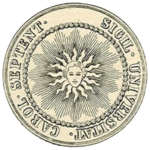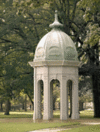East Carolina University
| East Carolina University | |
|---|---|
 |
|
| Motto | Servire (Latin) |
| Motto in English | To Serve |
| Established | March 8, 1907 |
| Type | Public university, Sea Grant University |
| Endowment | USD$89.0 million[1] |
| Chancellor | Steven Ballard |
| Academic staff | 1,804[2] |
| Admin. staff | 5,354[2] |
| Students | 27,677[2] |
| Undergraduates | 20,974[2] |
| Postgraduates | 6,417[2] |
| Location | Greenville, North Carolina, USA |
| Campus | Urban area, Main Campus: 530 acres (2 km2); Health Sciences Campus: 206 acres (1 km2); West Research Campus: 650 acres (3 km2); Total: 1,386 acres (6 km2) |
| Slogan | Tomorrow starts here. |
| Colors | Purple and Gold |
| Athletics | NCAA Division I, Conference USA, 19 varsity teams |
| Nickname | Pirates |
| Mascot | PeeDee the Pirate |
| Website | www.ecu.edu |
East Carolina University is a public, coeducational, engaged doctoral/research university located in Greenville, North Carolina, United States. Named East Carolina University by statute and commonly known as ECU or East Carolina, the university is the largest institution of higher learning in eastern North Carolina and the third-largest university in North Carolina (second-largest according to US News and World Report which uses Undergraduate Admission as its determinant). With a Fall 2009 enrollment of 27,677 students, it is the fastest-growing campus in the University of North Carolina system for six consecutive years.[3]
The North Carolina General Assembly founded ECU on March 8, 1907 as a teacher training school and selected Greenville as its seat on July 2, 1908 with the first classes beginning in 1909. While East Carolina has historical strengths in education, nursing, business, music, theater, and medicine, it offers over 100 Bachelor degree areas of study including mathematics, hospitality management, engineering, construction management, computer science, exercise physiology, political science, social work,and environmental health.[4]
East Carolina's name changed from East Carolina Teachers Training School (ECTTS) in 1907 to East Carolina Teachers College (ECTC), then East Carolina College (ECC), and finally, in 1967, to East Carolina University (ECU).[5] The change in its name reflects the changed mission. Originally the school was established to train teachers for North Carolina, specifically the eastern part of the state. Today, ECU continues to serve eastern North Carolina in a larger capacity. The Brody School of Medicine at East Carolina University brings much needed medical care to the impoverished area.[6] The Small Business Institute, through the College of Business, offers assistance and advice to small business owners.[7]
East Carolina has grown from 43 acres (17 ha) in 1907 to almost 1,600 acres (647 ha) today.[8] The university's academic facilities are located on four properties: Main, Health Sciences, West Research facility, and the Field Station for Coastal Studies in New Holland, North Carolina.[9][10] The nine undergraduate colleges, graduate school, and two professional schools are all located on these four properties.[11] All of the non-health sciences majors are located on the main campus. The College of Nursing, College of Allied Health Sciences, The Brody School of Medicine and School of Dental Medicine are located on the health science campus. There are nine social sororities ,16 social fraternities, four historically black sororities, five historically black fraternities, one Native American fraternity, and one Native American sorority.[12] Along with Greek life, there are over 300 registered clubs on campus[13]
Contents |
History
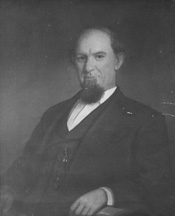
Public Laws of North Carolina, 1907, Chapter 820 titled An Act to Stimulate High School Instruction in the Public Schools of the State and Teacher Training is the official law chartering East Carolina Teachers Training School (ECTTS) on March 8, 1907 by the North Carolina General Assembly.[14] The chairman of its original Board of Trustees, Thomas Jordan Jarvis, a former Governor of North Carolina now known as the "Father of ECU", participated in groundbreaking ceremonies for the first buildings on July 2, 1908 in Greenville, North Carolina and ECTTS opened its doors on October 5, 1909.[5][15] Although its purpose was to train "young white men and women", there were no male graduates until 1932.[16] In 1920, ECTTS became a four–year institution and renamed East Carolina Teachers College (ECTC); its first bachelor's degrees were awarded the following year in education.[5] A master's degree program was authorized in 1929; the first such degree granted by ECTC was in 1933.[5] Progress toward full college status was made in 1948 with the designation of the bachelor of arts as a liberal arts degree, and the bachelor of science as a teaching degree.[17] A change of name to East Carolina College in 1951 reflected this expanded mission.[5] Over the objections of Governor Dan K. Moore, who opposed the creation of a university system separate from the Consolidated University of North Carolina, ECC was made a regional university effective July 1, 1967, and assumed its present name, East Carolina University. The university did not remain independent for long; on July 1, 1972, it was incorporated into the University of North Carolina System, the successor to the Consolidated University.[5] Today, ECU is the third–largest university in North Carolina with 20,974 undergraduate and 6,417 graduate students, including the 286 Brody School of Medicine students.[2][18]
Campus
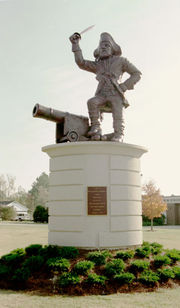
East Carolina is separated into three distinct campuses: Main Campus, Health Sciences Campus, and West Research Campus. It owns two sports complexes: Blount Recreational Sports Complex and North Recreational Complex. It owns a field station in New Holland, North Carolina.

Main
The main campus, also known as the east campus, is about 530 acres (2 km2) in an urban residential area of downtown Greenville. The 158 buildings on main campus comprise more than 4.6 million square feet (325,000 m²) of academic, research, and residential space.[9] Many of the Main Campus buildings feature the Spanish–Mission style architecture; inspiration drawn from Thomas Jarvis' time as an ambassador to Brazil.[19][20] He wanted to bring the unique architecture to eastern North Carolina. On the main campus, there are 15 residence halls which are divided into three separate neighborhoods.[21] The distinct feature of the main campus is the mall, which is a large tree–laden grassy area where many students go to relax. In the middle of the mall is the replica of the cupola on the original Austin building.
Health Sciences
The Health Sciences campus is situated beside Pitt County Memorial Hospital (PCMH). PCMH, a 745–bed flagship Level I Trauma Center, serves as the academic medical center for The Brody School of Medicine.[22] University Health Systems of Eastern Carolina owns PCMH and five other hospitals, while managing two other.[23] The area is about 2 miles (3.2 km) west of Main Campus on 206 acres (0.8 km2) with nearly 1,300,000 square feet (121,000 m2) of academic and research space in 62 buildings.[9] Other buildings besides PCMH include The Brody School of Medicine, the East Carolina Heart Institute, Leo Jenkins Cancer Center, and the Allied Health building composed of the School of Nursing, Laupus Medical Library and College of Allied Health Sciences.[24][25] The 117,000 square feet (11,000 m2) Family Medicine Center and School of Dental Medicine are both currently being built.[26][27]
West Research
West Research Campus lies on approximately 600 acres (2.4 km2) 4 miles (6.4 km) west of the Health Sciences Campus. It consists of a 27,000-square-foot (2,500 m2) building on the former Voice of America site[28] and large areas of biology, botany and other sciences field study sites. It has an environmental health onsite wastewater demonstration facility which is open to the public and all educators. It is also the home of the North Carolina Institute for Health and Safety in Agriculture, Forestry, and Fisheries with an administrative and several support buildings.[29]
Field Station for Coastal Studies
The field station is located in New Holland, North Carolina. The area serves as a field station for the coastal studies, coastal resource management, and biology programs.[10] The main goal of the field station is economic development into the region through both environmental education and eco–tourism.[30] It also serves as a facility for small retreats and as a base for research on coastal issues.[31] It was listed on the National Register of Historic Places in 1980.[32] It is adjacent to the 49,925-acre (202 km2) Mattamuskeet Wildlife Refuge.

North Recreational Complex
North Recreational Complex (NRC) is an athletic complex located on a 129-acre (0.5 km2) parcel of land north of East Carolina University’s main campus. The NRC is one of the Nation's largest recreational complexes. It will augment the Blount Intramural Sports Fields located behind the Carol Belk Building on Charles Boulevard. The first of three phases of the complex opened on September 2, 2008.[33] Phase one includes eight lighted fields, a 5.6 acres (0 km2) lake with a beach, walking trails/areas, and a field house. The complex is located near the intersection of the North Carolina Highway 33 and U.S. Route 264.[34][35]
Colleges and schools
ECU is home to nine undergraduate colleges, a graduate school, and two professional schools. The oldest school is the modern day College of Education. The Dental school is under construction and will increase the professional schools to two.
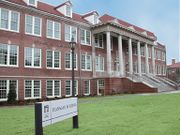
The liberal arts college at East Carolina University is the Thomas Harriot College of Arts and Sciences.[36] It consists of 16 departments, making it the fourth largest school at East Carolina University, after the College of Education, the College of Technology and Computer Science, and the College of Fine Arts and Communication.[37] The liberal arts college has its roots in the beginning of the University.[38]
The College of Business consists of five undergraduate majors with concentrations in each, plus a Master of Business Administration and Master of Science in Accounting program. The College beginnings came in 1936 when the Department of Commerce was organized. It later changed to the Department of Business Education, and then to the Department of Business. Finally, in 1960, the School of Business was formed.[39] The college undergraduate programs was accredited in 1967, and the graduate programs was accredited in 1976 by The Association to Advance Collegiate Schools of Business.[40] The college is a governing school of the Graduate Management Admission Council.[41] The college runs a Small Business Institute to advise small business owners on how to succeed.[7]
The College of Education is the oldest and largest college at ECU. It houses and administers all of the education majors. There are 17 undergraduate degree programs, 22 graduate degree programs, six advanced certifications and the EdD program. The College prepares more professionals for North Carolina schools than any other university in the state. The College scored higher than other North Carolina universities when the state board evaluated teacher education programs in 2006. In addition, the Institution of Higher Education Performance Report showed ECU was first in the number of graduates who were employed in public schools across the state.[42] The college is considered one of the exemplary professional preparation programs according to the North Carolina State Board of Education’s Higher Education Performance Report.[43]
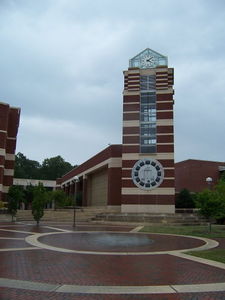
The College of Fine Arts and Communication comprises four schools that range from dance to design and broadcast journalism. The college officially opened on July 1, 2003, but can trace its roots to ECU founding; the school hired art and music professionals in 1907 to train teachers.[44]
The College of Health and Human Performance is made up of three departments and handles all of the recreational and exercise degrees at East Carolina University. It took on its name in 2003, but traces its legacy to the Department of Physical Education in 1930. It was the 1930 East Carolina Teachers College Planning Document number two priority. In 1938, the Department of Physical Education was established and PE became a specialty area for high school teachers.[45]
The College of Human Ecology houses four departments and one school along with two institutes. It was first incorporated in 1968 and started to admit students in 1971.[46] "The Carolyn Freeze Baynes Institute for Social Justice is an international forum for addressing questions, presenting ideas, and developing innovations. The Institute's focus in these activities is the identification of injustices and development of more just alternatives through systematic professional research, scholarship, and public presentation of findings and ideas."[47]
The College of Technology and Computer Science comprises three departments. The college now offers a BS in Engineering.[48] The college offers eight other degrees along with engineering including computer science, construction management, design, distribution and logistics, industrial engineering technology, information and computer technology, and industrial technology.[49] The College of Allied Health Sciences encompasses the other health science majors. The school offers over 15 majors. All of the health sciences majors are located in the Allied Health Sciences building which is in the West Campus beside The Brody School of Medicine. It was established in the 1967–68 school year.[50]
The College of Nursing comprises one undergraduate major, Nursing. The school was created in 1959 and now offers Bachelor of Science, Masters, and PhD program. The 100+ faculty teaches the students everything about the nursing field while practicing in the under served Eastern North Carolina.[51] On October 12, 2007, the University of North Carolina Board of Governors permitted the re–designation of the School of Nursing to the College of Nursing.[52]
The Graduate School consist of 69 masters degree, 41 certificate, and 18 doctoral programs. It coordinates the graduate offerings of all departments in the nine colleges. The School also runs the non–professional degree programs of the professional School of Medicine.[53][54][55]
The Brody School of Medicine is a professional school at the university. It consists of seven graduate majors, plus the medical degree, all located on the Health Sciences Campus. The first appropriations were approved in 1974, with the first medical students arriving in 1977. The medical school is one of four in North Carolina.
The School of Dental Medicine is a professional school at the university. The school graduates one degree, dentistry. It was founded on February 24, 2006 at the East Carolina Board of Trustees meeting.[56] The dental school was unanimously approved by the UNC System Board of Governors as well.[48][57][58] The facilities are located on the Health Sciences Campus and will house the first three years of education. Dental students will complete their final year at one of the ten Community Dental Centers located throughout the state.
Student life
Libraries
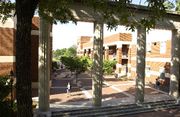
J.Y. Joyner Library is located on the main campus and holds nearly 1.3 million bound volumes, 2.5 million pieces of microform, 532,000 government documents, more than 24,000 journal subscriptions.[59] Joyner Library is located beside the ECU Mall. The Music Library is a branch of Joyner housing almost 78,000 items. It is located on the first floor of A.J. Fletcher Music Center.[60] Lastly, there is the Laupus Library. It holds 158,457 volumes (print and non–print) and 8,712 current print, non–print, and electronic serial titles.[61]
Greek life
There are nine social sororities at the East Carolina Campus, all of which own a house located at or near 5th or 10th Street. There are currently 16 social fraternities at East Carolina. The majority are located off or near 5th Street or 10th Street. Of the 16 social fraternities, seven currently do not own a house. Greek life started in 1958 with the introduction of four social fraternities: Kappa Alpha Order, Lambda Chi Alpha, Pi Kappa Alpha, and Theta Chi. Two years later, eight of the nine social sororities were founded.[62]
National Pan-Hellenic Council (NPHC) has a presence on campus, as well. There are four historically black sororities and five historically black fraternities.[12][62] There are over 18 honor and 13 service or religious fraternities or sororities at ECU.
Athletics
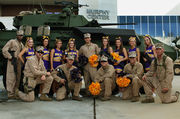
ECU's sports teams, nicknamed the Pirates, compete in NCAA Division FBS as a full–member of the 12 team Conference USA. Terry Holland is the Athletic Director.[63][64] The football team is supported by world-class spirit groups, such as the East Carolina University Marching Pirates, National Award winning Cheerleading squads, and spirit teams. Facilities include the 50,000 seat Dowdy-Ficklen Stadium for football, the 8,000–seat Williams Arena at Minges Coliseum for men's and women's basketball, and Clark-LeClair Stadium, with a seating capacity of 3,000 (max capacity of 6,000+ when including outfield "Jungle" areas) for baseball. The Ward Sports Medicine building comprises 82,095-square-foot (7,600 m2) and houses the athletic department, Pirate Club offices and the Human Performance Laboratory. Athletes train in the Murphy Center a 52,475-square-foot (4,875 m2) edifice, housing the strength and conditioning facilities, along with banquet rooms, sport memorabilia, and an academic enhancement center. The Murphy Center was built for approximately $13 million and opened its doors to ECU student–athletes in June 2002.[63][65]
Traditions and events
There are 314 registered organizations that contribute to a diverse and vibrant student life.[13] Barefoot on the Mall is held every spring on the mall, gathering musicians from all genres for an all–day concert and features various games, rides, and food vendors.[66] Freeboot Fridays are held every Friday evening before home football games in uptown Greenville. It offers free concerts, free food, children’s activities, and a beer and wine garden for adults.[67] The Billy Taylor Jazz Festival gathers musicians from all parts of the world to participate in this unique two–day event.[68] The Purple & Gold Pigskin Pigout Party, held each spring, is a celebration of football at East Carolina. This event features a carnival, various cooking contests including a pork barbecue team cookoff, a car show, a celebrity golf tournament, a parade, free live entertainment, and the annual Purple & Gold spring football game.[69]
Administration
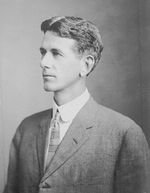
There have been six presidents and seven Chancellors in the university's history.[70] Robert Herring Wright was inaugurated as the first president of ECTTS on November 13, 1909. The chief administrator changed names after ECU joined the UNC System in 1972. The chancellor is chosen by the University of North Carolina Board of Governors on the recommendation of the board's president, and he reports to the 12–member Board of Trustees at ECU. Four of the twelve trustees are picked by the Governor of North Carolina, while the other eight are picked by the Board of Governors. The ECU student body president is an ex officio member of the Board of Trustees.[71] The current chancellor, Steven Ballard, has held that post since replacing interim chancellor William E. Shelton on June 1, 2004.[72]
The University of North Carolina Board of Governors are the policy-making body legally charged with "the general determination, control, supervision, management, and governance of all affairs of the constituent institutions." It has 32 voting members who are elected by the General Assembly for four-year terms. The current president of the University of North Carolina is Erskine Bowles.
Rankings
In 2010, Forbes Magazine ranked the school 36th in its America's Best College Buys story.[73] In the 2009 edition of U.S.News & World Report, The Brody School of Medicine at East Carolina is ranked 28th in the country for primary care physician preparation and seventh in the rural medicine specialty.[74] In 2010, Brody was ranked seventh on the social mission scale.[75]
ECU is currently classified by U.S. News & World Report as a National University[76] in its second-tier rankings. East Carolina University was named a GetEducated.com Best Buy for affordability and quality in the Online Masters of Business Administration (AACSB-accredited) category in fall 2007.[77] In 2009, the university was awarded the Patriot Award. The Patriot Award recognizes employers who go above and beyond what the law requires in supporting their employees who serve in the National Guard or reserves.[78] In 2010, the university was awarded the Secretary of Defense Employer Support Freedom Award. It is the highest recognition given by the U.S. Government to employers for their outstanding support of their employees who serve in the Guard and Reserve.[79]
Notable people

Pirate graduates have been influential in teaching, business, and the arts. The most notable teaching alumnus is Ron Clark, a teacher, author, and founder of the Ron Clark Academy in Atlanta, Georgia.[80] Actress Emily Procter, Beth Grant, and screenwriter Kevin Williamson, creator of Scream and Dawson’s Creek, graduated from East Carolina. Acclaimed screen actress Sandra Bullock attended, but graduated later after leaving to pursue her acting career.[81][82][83] Class of 1974 Alumnus Rick Atkinson, wrote An Army at Dawn: The War in North Africa, 1942–1943 followed by "The Day of Battle, The War in Sicily, 1943–1944" and Dan Neil wrote criticism on automobiles; both received Pulitzer Prizes.[84][85] James Maynard graduated with a degree in psychology and founded the Golden Corral restaurant chain.[86] Kelly King is the current chief executive officer for BB&T and graduated with an undergraduate degree in business accounting and a master's of business administration.[87] Jacksonville Jaguars quarterback David Garrard attended where he majored in Construction Management.[88] Chris Johnson was drafted by the Tennessee Titans in the first round of the 2008 NFL Draft. World Wrestling Entertainment chairman Vincent K. McMahon and his wife Linda McMahon both graduated with a degree in business administration as well.[89] Scott Avett of the folk-rock band The Avett Brothers earned degrees in 1999 and 2000.[90]
References
- ↑ As of June 30, 2009. "U.S. and Canadian Institutions Listed by Fiscal Year 2009 Endowment Market Value and Percentage Change in Endowment Market Value from FY 2008 to FY 2009" (PDF). 2009 NACUBO-Commonfund Study of Endowments. National Association of College and University Business Officers. p. 9. http://www.nacubo.org/Documents/research/2009_NCSE_Public_Tables_Endowment_Market_Values.pdf. Retrieved March 3, 2010.
- ↑ 2.0 2.1 2.2 2.3 2.4 2.5 "Fact Book 2008–2009". East Carolina University. 2009. http://www.ecu.edu/cs-admin/ipre/FactBook2009.cfm. Retrieved 2009-11-16.
- ↑ "East Carolina University". Featured Campus Profiles. US Journal of Academics. June 2007. http://www.usjournal.com/en/students/campuses/ecu.html. Retrieved 2007-06-11.
- ↑ "Overview". East Carolina University. University of North Carolina. 2007. http://www.unconline.net/site.php?id=2923. Retrieved 2007-06-11.
- ↑ 5.0 5.1 5.2 5.3 5.4 5.5 Representatives McLawhorn, E. Warren, and Williams (2007-03-05). "House Joint Resolution 460: A Joint Resolution honoring East Carolina University on the University's Centennial Anniversary" (PDF). General Assembly of North Carolina. http://www.ncleg.net/Sessions/2007/Bills/House/PDF/H460v1.pdf. Retrieved 2007-06-10.
- ↑ "History: A Legacy of Commitment". About the School. The Brody School of Medicine. January 15, 2007. http://www.ecu.edu/cs-dhs/med/abtHistory.cfm. Retrieved 2007-07-16.
- ↑ 7.0 7.1 "Small Business Institute". College of Business. East Carolina University. 2007-06-22. http://www.ecu.edu/cs-bus/sbi.cfm. Retrieved 2007-07-15.
- ↑ "Greenville Gets the School". The Daily Reflector. July 11, 1907. pp. 2. http://www.ecu.edu/cs-lib/archives/pr_display.cfm?id=563. Retrieved 2007-07-14.
- ↑ 9.0 9.1 9.2 "Facilities". Quick Facts. East Carolina University. February 16, 2010. http://www.ecu.edu/cs-admin/mktg/points_east_quick_facts_07.cfm. Retrieved 2010-02-20.
- ↑ 10.0 10.1 "ECU Field Station for Coastal Studies at Mattamuskeet". Mattamuskeet Field Station. College of Arts and Sciences - East Carolina University. 2001. http://www.ecu.edu/artsci/matt/mattamuskeet.htm. Retrieved 2007-06-11.
- ↑ "Brief Description" (PDF). East Carolina University. The University of North Carolina - General Administration. June 30, 2006. http://intranet.northcarolina.edu/docs/assessment/Profiles/2006-07/Inst.Prof._2006ECU.pdf. Retrieved 2007-07-16.
- ↑ 12.0 12.1 "Chapters". Greek Life. Division of Student Life. 2007-04-11. http://www.ecu.edu/artsci/matt/mattamuskeet.htm. Retrieved 2007-06-11.
- ↑ 13.0 13.1 "East Carolina University". America's Best Colleges 2007. U.S. News & World Report. 2007. http://www.usnews.com/articles/education/best-colleges/2009/08/19/methodology-ranking-category-definitions.html. Retrieved 2007-06-10.
- ↑ "An Act to Stimulate High School Instruction in the Public Schools of the State and Teacher Training". North Carolina Public Laws 1907, Chapter 820. North Carolina General Assembly. 1907-03-08. http://www.ecu.edu/cs-lib/archives/pr_display.cfm?id=49. Retrieved 2007-06-10.
- ↑ ECU - News Bureau (2007). "Joyner Library exhibit features "father" of ECU". Press release. http://www.ecu.edu/cs-admin/news/releases/2007/2/02082007ecujarvisexhibit.cfm. Retrieved 2007-06-10.
- ↑ Pieces of Eight (1982-02-15). "An East Carolina Memoir by Henry C. Oglesby". Press release. http://www.ecu.edu/cs-lib/archives/pr_display.cfm?id=982. Retrieved 2007-06-10.
- ↑ "East Carolina University Timeline". University Archives. East Carolina University - Joyner Library. 2007. http://www.ecu.edu/cs-lib/archives/timeline.cfm. Retrieved 2007-06-10.
- ↑ Criscito, Pat (1999). Barron's Guide to Distance Learning: Degrees, Certificates, Courses. Barron's Educational Series. pp. 209. ISBN 0764117912. http://books.google.com/books?id=AmJBgoTdGrUC.
- ↑ "Thomas Jordan Jarvis - Father of East Carolina University". Joyner Library, East Carolina University. 2007. http://www.ecu.edu/cs-lib/ncc/exhibit.cfm/. Retrieved 2007-06-11.
- ↑ National Governors Association (2004). "North Carolina Governor Thomas Jordan Jarvis". Governor's Information. National Governors Association. http://www.nga.org/portal/site/nga/menuitem.29fab9fb4add37305ddcbeeb501010a0/?vgnextoid=eea575cbecff1110VgnVCM1000001a01010aRCRD&vgnextchannel=e449a0ca9e3f1010VgnVCM1000001a01010aRCRD. Retrieved 2007-06-11.
- ↑ "Residence Halls". Residence Halls. East Carolina University - Campus Living. 2009. http://www.ecu.edu/studentlife/campusliving/halls.cfm. Retrieved 2010-02-20.
- ↑ "Pitt County Memorial Hospital". Pitt County Memorial Hospital. University Health Systems of Eastern Carolina. 2009. http://www.uhseast.com/pittcounty/dynamic-detail.aspx?id=388&linkidentifier=id&itemid=388. Retrieved 2010-02-20.
- ↑ "About University Health Systems of Eastern Carolina". University Health Systems of Eastern Carolina. 2009. http://www.uhseast.com/uhseast/dynamic-detail.aspx?id=492&linkidentifier=id&itemid=492. Retrieved 2010-02-20.
- ↑ "Division of Health Sciences". Division of Health Sciences. 2007. http://www.ecu.edu/dhs/. Retrieved 2007-06-11.
- ↑ "Leo W. Jenkins Cancer Center". ECU Physicians. 2008. http://www.ecu.edu/cs-dhs/ecuphysicians/customcf/maps/CancerCenter.pdf. Retrieved 2010-02-20.
- ↑ "ECU breaks ground for new Family Medicine Center". Division of Health Sciences News. 2008. http://www.ecu.edu/cs-dhs/dhs/newsStory.cfm?ID=606. Retrieved 2010-02-20.
- ↑ "Groundbreaking Ceremony". ECU School of Dentistry. 2008. http://www.ecu.edu/cs-dhs/dentistry/Complex.cfm. Retrieved 2010-02-20.
- ↑ Latham, Art (2002). "N.C. Agromedicine Institute obtains health research grant". Perspectives Online. North Carolina State University. http://www.cals.ncsu.edu/agcomm/magazine/spring02/agromed.htm. Retrieved 2007-06-11.
- ↑ "Mission, Vision, Goals". North Carolina Agromedicine Institute. http://www.ncagromedicine.org/mission.htm. Retrieved 2007-06-11.
- ↑ "Field Station for Coastal Studies at Mattamuskeet". ICW-NET, LLC.. 2004. http://www.albemarle-nc.com/mattamuskeet/studies/. Retrieved 2007-06-11.
- ↑ "Mattamuskeet Field Station" (PDF). East Carolina University. 2006-09. http://www.ecu.edu/cs-acad/rgs/upload/mattstat.pdf. Retrieved 2007-06-11.
- ↑ "Lake Mattamuskeet Pump Station". North Carolina - Hyde County. National Register of Historic Places. 1980. http://www.nationalregisterofhistoricplaces.com/NC/Hyde/state.html. Retrieved 2007-06-11.
- ↑ "North Recreational Complex". East Carolina University. 2007-12-03. http://www.ecu.edu/cs-studentlife/crw/facilities/north_complex/. Retrieved 2008-02-13.
- ↑ Facilities Engineering and Architectural Services - East Carolina University. "North Recreational Complex". Press release. http://www.ecu.edu/cs-admin/campus_operations/facilities_engineering_and_architectural_services/North-Fields-Recreation-Complex.cfm. Retrieved 2007-06-10.
- ↑ "ECU breaks ground on new athletic complex". ECU - News Bureau. 2006. http://www.ecu.edu/cs-admin/news/releases/2006/03/032906northreccomplex.cfm. Retrieved 2007-06-10.
- ↑ White, Alan (2007-03-05). "The Liberal Arts". Thomas Harriot College of Arts and Sciences. East Carolina University. http://www.ecu.edu/cs-cas/liberalarts/liberal-arts.cfm. Retrieved 2007-06-11.
- ↑ "Unduplicated Undergraduate Fall Enrollment History by Unit and Major (CIP)". Fact Book 2006 - 2007. East Carolina University. 2007. http://www.ecu.edu/cs-admin/ipre/customcf/factbook/factbook0607.pdf#page=59. Retrieved 2007-06-11.
- ↑ "Welcome to Thomas Harriot College of Arts and Sciences". Thomas Harriot College of Arts and Sciences. East Carolina University. 2006-09-25. http://www.ecu.edu/cs-cas/. Retrieved 2007-06-11.
- ↑ ECU Report, Volume 15, No. 1 (1983-01). "School of Business, One of Finest in the Country". Press release. http://www.ecu.edu/cs-lib/archives/pr_display.cfm?id=629. Retrieved 2007-06-11.
- ↑ "College of Business Statistics". About the College of Business. East Carolina University - College of Business. 2007-03-05. http://www.ecu.edu/cs-bus/collegestatistics.cfm. Retrieved 2007-06-11.
- ↑ "College of Business". Graduate Management Admission Council. 2007. http://www.ecu.edu/business/. Retrieved 2007-06-11.
- ↑ College of Education (2009). "College of Education Fact Sheet - Spring 2009" (PDF). Press release. http://www.ecu.edu/cs-educ/upload/COESpringFactSheet-09.pdf. Retrieved 2010-02-20.
- ↑ "College of Education Fact Sheet". East Carolina University College of Education. East Carolina University. 2007. http://www.ecu.edu/cs-educ/admin/COEFactSheet.cfm. Retrieved 2007-06-10.
- ↑ "About the College". ECU College of Fine Arts & Communication. College of Fine Arts & Communication. 2009-12-09. http://www.ecu.edu/cs-cfac/about2.cfm. Retrieved 2010-02-20.
- ↑ "History of the College of Health and Human Performance" (PDF). The College of Health & Human Performance. 2007-01-11. http://www.ecu.edu/cs-hhp/upload/HHP_HX_Timeline.pdf. Retrieved 2007-06-11.
- ↑ "History, Mission, and Vision of CHE". College of Human Ecology. East Carolina University. 2006-09-21. http://www.ecu.edu/che/history.html. Retrieved 2007-06-11.
- ↑ "The Carolyn Freeze Baynes Institute of Social Justice" (PDF). College of Human Ecology. 2007-04-23. http://www.ecu.edu/che/docs/Social%20Justice%20in%20Context2005Volume1.pdf. Retrieved 2007-06-11.
- ↑ 48.0 48.1 "Request for Authorization to Establish a Bachelor of Science Degree in Engineering at East Carolina University". Appendices for the minutes on March 19, 2004. The University of North Carolina. 2004-05-18. http://www.ecu.edu/che/docs/Social%20Justice%20in%20Context2005Volume1.pdf. Retrieved 2007-06-24.
- ↑ "College of Technology and Computer Science". College of Technology and Computer Science. East Carolina University. 2006-09-14. http://www.ecu.edu/cs-acad/aa/tcsdegrees.cfm. Retrieved 2007-06-24.
- ↑ "The College of Allied Health Sciences". East Carolina University. 2007-05-16. http://www.ecu.edu/ah/. Retrieved 2007-06-11.
- ↑ Brown, Sylvia T. (2007-06-11). "Welcome from the Dean". About us. School of Nursing. http://www.nursing.ecu.edu/about_us.htm. Retrieved 2007-06-11.
- ↑ ECU, Student (2007-10-23). "Two East Carolina University schools have been re–designated as colleges.". http://www.nursing.ecu.edu/press/2007_64.html. Retrieved 2007-12-06.
- ↑ "Masters Programs". Graduate School. East Carolina University. http://www.ecu.edu/gradschool/programs.cfm?type=degreelvl&value=2. Retrieved 2007-07-16.
- ↑ "Certificate Programs". Graduate School. East Carolina University. http://www.ecu.edu/gradschool/programs.cfm?type=degreelvl&value=3. Retrieved 2007-07-16.
- ↑ "Doctoral Programs". Graduate School. East Carolina University. http://www.ecu.edu/gradschool/programs.cfm?type=degreelvl&value=1. Retrieved 2007-07-16.
- ↑ "Board of Trustees Meeting" (PDF). East Carolina University. 2006-02-24. pp. 15–16. http://www.ecu.edu/cs-admin/bot/upload/002%20-%20Minutes-6.pdf. Retrieved 2007-06-10.
- ↑ Martin, Harold (2006-11-03). "Request to Establish a Doctor of Dental Surgery Degree Program at East Carolina University" (PDF). Appendix O. University or North Carolina Board of Governors. http://intranet.northcarolina.edu/content.php/docs/bog/bogdocs/2007-01/minutes/Appendix%20O.pdf. Retrieved 2007-06-10.
- ↑ "Doctor of Dental Surgery Degree Program at East Carolina University" (PDF). Report of the Committee on Educational Planning, Policies, and Programs. The University of North Carolina - Board of Governors. 2006-11-10. http://intranet.northcarolina.edu/docs/bog/minutes/2006/11-10-06_minutes-open.pdf. Retrieved 2007-06-10.
- ↑ "About Joyner Library". J.Y. Joyner Library, East Carolina University. 2006-03-14. http://www.ecu.edu/cs-lib/development/about.cfm. Retrieved 2007-06-11.
- ↑ "About the Music Library". Joyner Library, East Carolina University. 2006-10-06. http://www.ecu.edu/cs-lib/music/about.cfm.
- ↑ "History of the Library". Laupus Library. Laupus Library. 2007-02-27. http://www.ecu.edu/cs-dhs/laupuslibrary/historyofthelibrary.cfm. Retrieved 2007-06-11.
- ↑ 62.0 62.1 Lauten, Elizabeth (2007-03-08). "History of Greek Life". Pulse (The East Carolinian). http://media.www.theeastcarolinian.com/media/storage/paper915/news/2007/03/08/Pulse/History.Of.Greek.Life-2763411.shtml. Retrieved 2008-02-13.
- ↑ 63.0 63.1 "East Carolina". Conference USA. 2007. http://conferenceusa.cstv.com/schools/ecu/c-usa-ecu-body.html. Retrieved 2007-06-06.
- ↑ Myatt, Al (2004). "Bingo! Search mission accomplished". Bonesville.net. http://www.bonesville.net/Articles/AlMyatt/2004/09/090704_Myatt_News.htm. Retrieved 2007-06-06.
- ↑ Tuttle, Steve (2006). "Building the Future". East Magazine. http://www.ecu.edu/cs-admin/mktg/east/Campus-Expansion.cfm. Retrieved 2007-06-06.
- ↑ Trento, Adeline (2007-04-19). "'Pirates Do It Barefoot' on the Mall". The East Carolinian. http://media.www.theeastcarolinian.com/media/storage/paper915/news/2007/04/19/News/pirates.Do.It.Barefoot.On.The.Mall-2851281.shtml. Retrieved 2007-06-06.
- ↑ "Freeboot Friday". Uptown Greenville. 2007. http://www.uptowngreenville.com/about/what_we_do/events/Freeboot_Friday/. Retrieved 2007-06-06.
- ↑ Greenville Convention and Visitors Bureau (2007-03-28). "Billy Taylor Jazz Festival". Press release. Archived from the original on September 28, 2007. http://web.archive.org/web/20070928142122/http://www.visitgreenvillenc.com/news/article_view.asp?article_id=122. Retrieved 2007-06-06.
- ↑ "27th Annual Purple/Gold Pigskin Pig-Out Party". East Carolina Pirates. 2007. http://www.ecupirates.com/ot/ecu-pig-out-party.html. Retrieved 2007-06-06.
- ↑ "President/Chancellor Bios". Joyner Library - East Carolina University. 2006-02-22. http://www.ecu.edu/cs-lib/archives/pr_display.cfm?id=579. Retrieved 2007-06-11.
- ↑ "East Carolina University Board of Trustees". Board of Trustees - East Carolina University. 2006-02-22. http://www.ecu.edu/cs-lib/archives/pr_display.cfm?id=579. Retrieved 2007-07-05.
- ↑ The University of North Carolina (2004-03-19). "Ballard Named Chancellor of East Carolina University". Press release. http://www.northcarolina.edu/content.php/pres/news/releases/pr2004/20040319.htm. Retrieved 2007-06-06.
- ↑ "America's Best College Buys". America's Best Colleges. Forbes. August 11, 2010. http://www.forbes.com/2010/08/01/best-buys-colleges-money-opinions-colleges-10-value.html. Retrieved August 12, 2010.
- ↑ U.S. News & World Report (2007). "Top Medical Schools - Primary care". America's Best Graduate Schools 2009. U.S.News & World Report. http://www.usnews.com/usnews/edu/grad/rankings/med/brief/mdprank_brief.php. Retrieved 2008-11-14.
- ↑ Mullan, Fitzhugh; Chen, Candice; Petterson, Stephen; Kolsky, Gretchen; Spagnola, Michael (June 15, 2010). "The Social Mission of Medical Education: Ranking the Schools". Annals of Internal Medicine (Philadelphia, Pennsylvania: American College of Physicians) 153 (12): 804-811. http://www.annals.org/content/152/12/804.full. Retrieved July 09, 2010.
- ↑ "Best Colleges 2010". Best Colleges 2010. U.S. News & World Report. 2010. http://colleges.usnews.rankingsandreviews.com/best-colleges/greenville-nc/east-carolina-university-2923. Retrieved 2010-02-20.
- ↑ "Top Ranked Most Affordable Online MBAs - AACSB Accredited". http://www.geteducated.com/online-college-ratings-and-rankings/best-buy-lists/best-buy-online-masters-mba-aacsb. Retrieved 2009-05-07.
- ↑ "East Carolina University honored with Patriot Award". December 02, 2009. http://esgr.org/site/News/tabid/73/articleType/ArticleView/articleId/306/Default.aspx. Retrieved July 09, 2010.
- ↑ Phillips, Melissa (July 08, 2010). "Department of Defense Announces 2010 Secretary of Defense Employer Support Freedom Award Recipients". Employer Support Freedom Award. The Secretary of Defense Employer Support Freedom Award. http://www.freedomaward.mil/NewsRoom/PressReleases/2010FreedomAwardRecipients/South%20Carolina.aspx. Retrieved July 09. 2010.
- ↑ Churchill, Theresa (2007-06-10). "Best-selling author highlights upcoming diversity conference at Richland". Herald & Review. http://www.herald-review.com/articles/2007/06/10/news/local_news/1024087.txt. Retrieved 2007-06-10.
- ↑ "Sandra Bullock". IMDB. http://www.imdb.com/name/nm0000113/bio. Retrieved 2007-06-10.
- ↑ Procter, Emily (2005). "Bio". Emily Procter Official Site. Emily Procter. http://www.emilyprocter.com/bio.htm. Retrieved 2007-06-08.
- ↑ "Kevin Williamson Biography". Kevin Williamson. Yahoo TV. 2007. http://tv.yahoo.com/kevin-williamson/contributor/32825/bio. Retrieved 2007-07-08.
- ↑ "History". 2003 winner. Pulitzer Board. 200. http://www.pulitzer.org/awards/2003. Retrieved 2007-07-08.
- ↑ "History". 2004 winner. Pulitzer Board. 200. http://www.pulitzer.org/awards/2004. Retrieved 2007-07-08.
- ↑ ECU Report (January 1981). "Successful Businessmen". Press release. http://www.ecu.edu/cs-lib/archives/pr_display.cfm?id=632. Retrieved 2007-07-08.
- ↑ "Kelly S. King". Executive Profile. BB&T. http://bbt.mediaroom.com/index.php?s=18&item=100. Retrieved 2010-01-01.
- ↑ "David Garrard". Jacksonville Jaguars. http://www.jaguars.com/team/Player.aspx?id=1843. Retrieved 2008-02-08.
- ↑ "Vince McMahon Biography (1945-)". A&E Television Networks. 2007. http://www.biography.com/search/article.do?id=9542235. Retrieved 2008-02-08.
- ↑ http://www.ecu.edu/cs-admin/mktg/east/Spring_2009_Cover_Story.cfm
External links
 Media related to East Carolina University at Wikimedia Commons
Media related to East Carolina University at Wikimedia Commons- Official website
|
||||||||||||||
|
||||||||||||||||
|
||||||||||||||||||||||||||||||||||||||||||||||||||||||||||||
